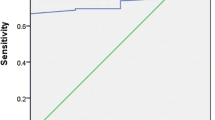Abstract
Background
Low alanine aminotransaminase (LALT) levels may be seen in patients with inflammatory bowel disease (IBD), but there has been no study about the frequency and its clinical significance. We aimed to analyze the frequency of LALT, and its clinical significance in children with IBD.
Methods
The study included the 89 patients with IBD without hepatobiliary involvement. LALT was defined as ALT levels < 5 U/L. Demographic and clinical findings and outcome of the patients with and without LALT were compared.
Results
LALT was found 47.1% of the patients. At initial examination, it was more common in female patients (92.3 vs. 41.3%, P < 0.001) and patients with CD (57.7 vs. 30.2%, P = 0.01). 75% of the patients with penetrating Crohn’s disease (CD) had LALT (P = 0.002). Hemoglobin (10.4 ± 2.1 vs. 11.7 ± 1.9 g/dL, P = 0.01), folic acid (5.2 ± 3.3 vs. 8.6 ± 5.9 ng/mL, P = 0.02) and serum albumin levels (3.6 ± 0.8 vs. 4.7 ± 5 g/dL, P = 0.002) were significantly low in patients with LALT. LALT was associted with the disease relapse within 2 weeks in 12 of the 16 patients with LALT whereas it was seen in 16 of the 73 patients without LALT during the follow-up (75 vs. 21.9%, P < 0.001). Additionally, steroid dependency was more common in patients with LALT during the follow-up (62.5 vs. 12.3%, P < 0.001).
Conclusions
LALT is common in children with IBD especially in CD and associated with low hemoglobin, albumin and folic acid levels. It may be a marker of relapse and steroid dependency.
Similar content being viewed by others
References
Ashton JJ, Harden A, Beattie RM. Paediatric inflammatory bowel disease: improving early diagnosis. Arch Dis Child. 2018;103:307–8.
Saubermann LJ, Deneau M, Falcone RA, Murray KF, Ali S, Kohli R, et al. Hepatic issues and complications associated with inflammatory bowel disease: a clinical report from the NASPGHAN Inflammatory Bowel Disease and Hepatology Committees. J Pediatr Gastroenterol Nutr. 2017;64:639–52.
Sette LH, Almeida Lopes EP. Liver enzymes serum levels in patients with chronic kidney disease on hemodialysis: a comprehensive review. Clin (Sao Paulo). 2014;69:271–8.
Lum G. Low activities of aspartate and alanine aminotransferase: their significance in alcoholic liver disease. Lab Med. 1995;4:273–6.
Elinav E, Ackerman Z, Maaravi Y, Ben-Dov IZ, Ein-Mor E, Stessman J. Low alanine aminotransferase activity in older people is associated with greater long-term mortality. J Am Geriatr Soc. 2006;54:1719–24.
Ruhl CE, Everhart JE. The association of low serum alanine aminotransferase activity with mortality in the US population. Am J Epidemiol. 2013;178:1702–11.
Vavricka SR, Rogler G. Intestinal absorption and vitamin levels: is a new focus needed? Dig Dis. 2012;30:73–80.
Hwang C, Ross V, Mahadevan U. Micronutrient deficiencies in inflammatory bowel disease: from A to zinc. Inflamm Bowel Dis. 2012;18:1961–81.
Levine A, Koletzko S, Turner D, Escher JC, Cucchiara S, de Ridder L, et al. ESPGHAN revised porto criteria for the diagnosis of inflammatory bowel disease in children and adolescents. J Pediatr Gastroenterol Nutr. 2014;58:795–806.
Stange EF, Travis SP, Vermeire S, Beglinger C, Kupcinkas L, Geboes K, et al. European evidence based consensus on the diagnosis and management of Crohn's disease: definitions and diagnosis. Gut. 2006;55(Suppl 1):i1–i15.
Vadstrup S. Subnormal alanine aminotransferase values in blood of patients with Crohn disease. Scand J Gastroenterol. 2004;39:554–6.
Erzin Y, Uzun H, Celik AF, Aydin S, Dirican A, Uzunismail H. Hyperhomocysteinemia in inflammatory bowel disease patients without past intestinal resections: correlations with cobalamin, pyridoxine, folate concentrations, acute phase reactants, disease activity, and prior thromboembolic complications. J Clin Gastroenterol. 2008;42:481–6.
Ueland PM, Ulvik A, Rios-Avila L, Midttun Ø, Gregory JF. Direct and functional biomarkers of vitamin B6 status. Annu Rev Nutr. 2015;35:33–70.
Poustchi H, George J, Esmaili S, Esna-Ashari F, Ardalan G, Sepanlou SG, et al. Gender differences in healthy ranges for serum alanine aminotransferase levels in adolescence. PLoS One. 2011;6:e21178.
Liu Z, Que S, Xu J, Peng T. Alanine aminotransferase-old biomarker and new concept: a review. Int J Med Sci. 2014;11:925–35.
Liverani E, Scaioli E, Digby RJ, Bellanova M, Belluzzi A. How to predict clinical relapse in inflammatory bowel disease patients. World J Gastroenterol. 2016;22:1017–33.
Galgut BJ, Lemberg DA, Day AS, Leach ST. The value of fecal markers in predicting relapse in inflammatory bowel diseases. Front Pediatr. 2018;5:292.
Chow DK, Sung JJ, Tsoi KK, Wong VW, Wu JC, Leong RW, et al. Predictors of corticosteroid-dependent and corticosteroid-refractory inflammatory bowel disease: analysis of a Chinese cohort study. Aliment Pharmacol Ther. 2009;29:843–54.
Funding
No financial or nonfinancial benefits have been received or will be received from any party related directly or indirectly to the subject of this article.
Author information
Authors and Affiliations
Contributions
MC participated in the design of the study and drafted the manuscript and carried out the statistical analysis. ES participated in the design of the study and drafted the manuscript and collected the clinical data. GD collected the clinical data and helped to draft the manuscript. FU collected the clinical data and participated in the design of the study and critical revision of the article for the important content. EK collected the clinical data and participated in the design of the study and critical revision of the article for the important content. All authors had read and approved the final manuscript.
Corresponding author
Ethics declarations
Ethical approval
The study was approved by the Karadeniz Technical University, Faculty of Medicine, Scientific Research Ethic Committee, Reference Number 2018/270.
Conflict of interest
The author(s) declare that they have no competing interests.
Rights and permissions
About this article
Cite this article
Cakir, M., Sag, E., Dogan, G. et al. Clinical significance of low transaminase levels in children with inflammatory bowel disease. World J Pediatr 15, 143–147 (2019). https://doi.org/10.1007/s12519-019-00235-5
Received:
Accepted:
Published:
Issue Date:
DOI: https://doi.org/10.1007/s12519-019-00235-5




